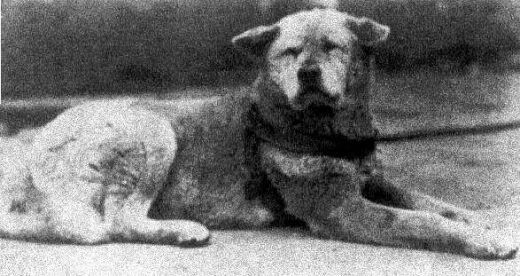|
The Siberian Husky: Large Breed Worker in a Compact Body History: The Siberian Husky got its start among most other sledding breeds, with arctic tribes in North East Asia. Our best guess as to the actual domestication of the dog is vague, but somehow the dogs figured out they get easy meals if they stick around humans, and the people figured out dogs were cheap labor. So, they developed a loose bond, where the dogs were actually "wild" for most of the year, but when food would go scarce around winter (conveniently enough, when the people needed the dogs for sled work) they'd migrate back to towns where the townspeople would throw them on a lead and keep them to work for the season. Over time the different tribes developed different needs for their dogs, and this is where the different breeds developed. Huskies in particular come from the Chukchi tribe who lived along the Pacific and Arctic coasts. Where other tribes further inland used reindeer for hauling and therefor developed their dogs into herders, the Chukchi used their dogs themselves for hauling heavy loads long distances. What they developed was a compact, energetic sled dog that had a body built not only for endurance but also speed. It was the compact nature of the dog that got it laughed at when it arrived in Alaska in 1908. where the dogs mushers were accustomed to seeing were similar to Malamutes with big bone and long legs, weighing around 80lbs, huskies were nearly half that size at around 40-50lbs with a comparably smaller frame. what the Alaskan mushers didn't realize is that the smaller, sleeker structure not only lent itself to hauling but was ideal for endurance and speed not found in their own dogs. Here's an excerpt from the Siberian Husky Club of America on the breed coming to Alaska: SHCA posted:The Siberian Husky arrived in North America in the fall of 1908 without fanfare. Most other dogs had taken the more conventional route to our shores across the Atlantic Ocean from countries where they had become well established breeds. This unknown breed of Northern dog, however, sneaked through a remote back door to America quietly and unobtrusively at a point where the peninsulas of Asia and America almost meet. From there, the popularity of those little "Siberian Rats" skyrocketed. The race, and subsequent races where more mushers opted for the smaller dogs, showcased exactly how efficient the Siberian's structure really was. Although by the 1920s Siberian dogs were well known throughout Alaska, the breed wouldn't gain national popularity until after the infamous Serum Run (which we honor with the Iditarod) in 1925: SHCA posted:In January 1925, Nome was gripped in a spreading diphtheria epidemic. The closest life-saving serum was over 600 miles away, so a dog team relay was formed to hasten its arrival. Seppala left Nome eastbound with 20 Siberians to meet the serum in Nulato, over 300 miles away on the Yukon River. Due to increased urgency for the medicine, the dog team relay continued west beyond Nulato and Seppala met a team carrying the serum package on the eastern shore of Norton Sound. In spite of already having run all day, and in the midst of a blizzard, Seppala turned his tired team around and, with his great leader Togo, made the perilous run back across the Sound to Golovin. A team led by Balto, and driven by Gunnar Kaasen, completed the last leg of the relay. A statue of Balto stands in New York's Central Park, honoring all of the sled dogs of the Serum Run. 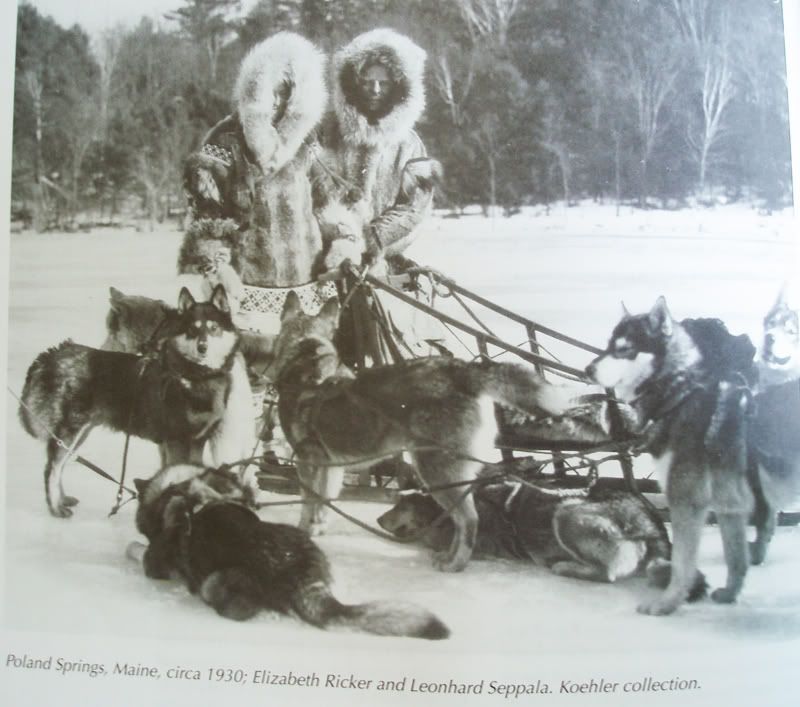 It was Seppala that developed the Siberian Husky into what we know today. Following the success of the Serum Run, Seppala took his team on a tour around the country to showcase the famous dogs. This helped the rest of the country to become aware of the small, Siberian dogs. While in New England, Seppala entered in races similar to those in Alaska, and not surprising, his team did amazing compared to the other, larger dogs. After all this, Seppala settled down and started a breeding plan with his dogs, not only focusing on performance like the Chukchi did, but also on giving the huskies a cohesive, physical standard that would actually set them apart as a breed. The Siberian Standard and the Working Dog: The Siberian Husky Standard posted:The Siberian Husky is a medium-sized working dog, quick and light on his feet and free and graceful in action. His moderately compact and well-furred body, erect ears and brush tail suggest his Northern heritage. His characteristic gait is smooth and seemingly effortless. He performs his original function in harness most capably, carrying a light load at a moderate speed over great distances. His body proportions and form reflect this basic balance of power, speed and endurance. The males of the Siberian Husky breed are masculine but never coarse; the bitches are feminine but without weakness of structure. In proper condition, with muscle firm As said, the standard for Siberians is rooted in their job as a working sled dog. When comparing huskies to "sprint racing" sled dogs seen in most sporting kennels today, it's important to note the difference in function. The key to the Siberian's structure is endurance. All of the angles set forth are meant to give the dog the best edge possible when running and pulling. Where sprint racing Alaskan Huskies (the mixed dogs used by mushers today) are bred for top speeds, they actually are at a disadvantage when it comes to longer hauls where actual loads are concerned. A fantastic example of this is was from a race back in the dawning of the breed which was recreated in the 80s, but using the sprint-bred dogs of today: SHCA posted:On the strength of their showing of speed and, particularly, endurance under the most trying conditions, Fox Maule Ramsay, a young Scotsman then in Nome and a competitor himself in the 1909 race, went to Siberia in the summer of 1909. Travelling up the Anadyr River to the trading settlement of Markovo, Ramsay procured around 60 of the best specimens of the breed he could find. He entered three teams of Siberians in the 1910 All Alaska Sweepstakes race, one for each of his uncles and one he drove himself. The team entered in the name of Col. Charles Ramsay and driven by John "Iron Man" Johnson, a Swedish Finn, came in first with an elapsed time of 74 hours, 14 minutes, 37 seconds, the best ever time for the 408 mile race held annually through 1917. Fox Ramsay came in second. The third Siberian team, entered for Col. Stuart and driven by Charles Johnson, placed 4th. (The 75th anniversary All Alaska Sweepstakes race was held in 1983, following the same trail and rules as the original race. The winner was 5 time Iditarod champion Rick Swenson. His time was over 10 hours slower than Iron Man Johnson's 1910 winning time.) While it's true that there isn't much use for the Siberian in the original function of the dog, it's still important for people passionate about the breed to work towards these goals and remember why the breed was developed in the first place, as opposed to changing the breed for the "fashion" of sprinting. These dogs are examples of Alaskan Huskies, bred for sprinting. Note how their structure is much more slender, similar more to sighthounds than hauling dogs. While they have tremendous speed in short bursts, they would lack the stamina of actually hauling a decent load for a long distance. 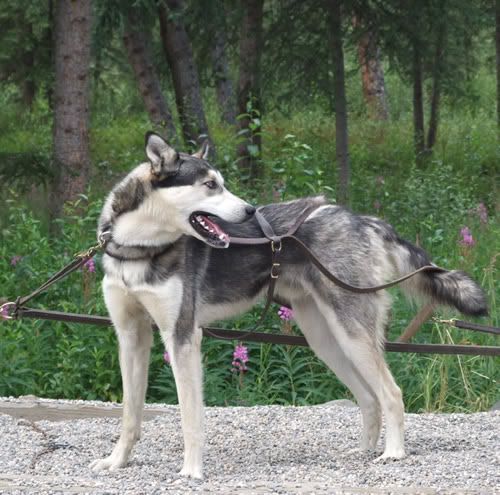 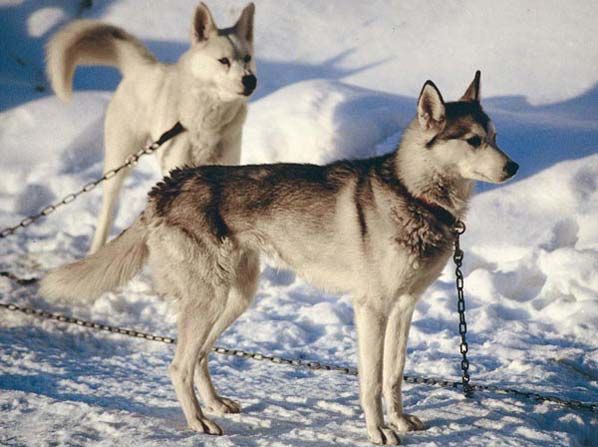 The Siberian Husky Show Dog: While there are definitely differences between kennels that work their dogs as opposed to those that only show, Huskies are one of the few breeds that haven't been warped too much by the show ring. The one main difference you'll notice, however, is size, particularly in the leg. Since the Husky is toted as a compact dog, it's been a trend in America lately to prize dogs with a shorter leg in the show ring. While it does look a bit flashier, looking closely at the short-legged dogs reveals their proportions are a bit off as a result. However, although you'll definitely see dogs gain their championships that have a bit of a stubby leg, you'll also see well proportioned dogs winning, as well. It seems that, like always, it comes down to politics and the judge's personal preference. Example of a Siberian Husky from a kennel that works their dogs (many dogs from this line take part in the Iditarod). This dog is well balanced and would likely have effective movement while pulling. This dog has her American championship.  Example of a Siberian Husky from a show kennel. One of the more extreme examples of shorter leg on a dog in relation to the body. Although he is a good example of "compact", his movement would likely not be as effective for puling as other huskies. This dog has his American and Canadian championships. 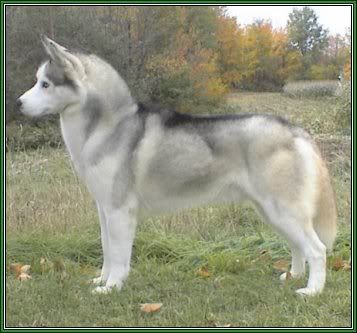 The Siberian Husky House Dog: It's no secret that huskies make difficult pets, like all primitive breed dogs. If you look at the reasons for those behaviors, however, it makes living with them not only manageable, but rewarding! You just have to remember you need to make a lot of concessions with your routine and training in order to compensate for the work ethic that makes huskies fantastic sled dogs. In order to understand how to handle a husky, you need to look at the traits they need to do their job. Obviously, the first think you think of is running! Huskies need to have the stamina and energy to run pretty much all day in harness. This results in an athletic, energetic, downright bouncy dog. A husky's energy level obviously needs to be channeled, but even with regular exercise they tend to be much more active around the house than a "normal" dog, even those with working or sporting backgrounds. They constantly want to see what's going on, especially with their families. They're also very jumpy and sensitive in that things other dogs wouldn't even glance at will catch a husky's attention. Since this is such a different activity level than most people are used to, it's important to spend a lot of time with huskies before actually bringing one home to figure out if this type of behavior is a good fit for your home. Another typical husky trait that many people are unaware of is that they were actually bred to ignore commands. That is, they were bred to ignore commands from a musher that may, unknowingly, try sending his team on to thin ice or some other such danger. The ability for sled dogs to think for themselves and put their own needs first is a life or death necessity out on the ice. At home, however, this manifests itself as a dog who goes through every thought process with a "What's in it for me?" attitude. (The same can be said for EVERY primitive breed dog.) Because of this, training needs to be kept fun, interesting, and most of all, rewarding. While you need to remain firm and consistent with your training or your dog will walk all over you, huskies and other primitive dogs are not the types to go out of their way to try to please you, so forms of training which are mainly correction based just won't cut it. So, you have a dog that likes to run and doesn't really care what you think. What does that mean? Keep your dog on a leash! This goes for ALL primitive breeds, but doubly so for sled dogs. If they get it in their head that they want to bolt, they are NOT going to hear you, no matter how fantastic their recall or training. This is probably the number one reason huskies wind up in rescue, because they manage to get out, run to their hearts content, then get lost. If you want a dog that you can take hiking off leash, this is not the breed for you. Although those are the big ones, here are some other husky-specific traits that may turn you away (or towards!) the breed: -Since huskies are bred to work in packs, they are super friendly dogs. They will not guard your stuff, but they probably will give an intruder tons of kisses. -Since huskies have that natural pack nature, they do well with other dogs. However, this attitude can result in a very dominant dog that wishes to "rule" the pack. Therefor, you need to choose your dogs wisely in order to keep the peace. This can really be said for any dogs, however. -All that energy can manifest itself in ways that are counter productive to a happy home. Bored huskies happily find things to do like destroying your home and yard (huskies are diggers!) It's important to cut this behavior off by giving your husky plenty of exercise, plenty of mental stimulation, and constant obedience training. -Huskies shed. A LOT. Don't listen to anything that says, "Oh, they only blow their coats once or twice a year." What they mean is, "Oh, they shed like normal dogs all year round, but it only gets REALLY bad once or twice a year. Or more, if you have a nice, climate controlled home." -Along with the "never off leash" thing, it's important to keep huskies well contained. They are smart, and they are MUCH more interested in things outside your fence/house than inside. They can dig under or climb over fences with ease, so if you want to let your dog outside unleashed, make sure the fence is at LEAST 6ft, but ideally more like 8ft and that you monitor your dog at all times. -Huskies, like all primitive breeds, have a high prey drive. While it's possible to work with dogs with pets at home and have them coexist, it's important to note that you'll likely still run into trouble outside with strays, rabbits, squirrels, etc. You'll need to take extra care when training out on walks to keep your dog from darting at any small, fast moving furry thing it sees. -Huskies make a lot of odd sounds. Everyone's aware with how they can howl, but they also tend to talk and "grumble" in ways that may even sound intimidating. This is another reason to visit with as many huskies as possible ahead of time, so you can learn to understand what the different sounds mean. Health, food, and metabolism: Despite the breed's popularity and high breeding levels, huskies remain a surprisingly healthy breed. Although it is important that breeders check at the very least check the dog's hips through OFA (or similar organization, after 2 years) and eyes through CERF (done yearly), there are really no genetic problems prone to the breed as in so many others. Because of this, huskies are a fantastic breed to acquire through rescue! Since even BYB dogs lean towards the healthy side, it's not necessary to either go to a good breeder or have a deep pocket book for future health issues. The Siberian's job and breeding again manifests itself when considering the dogs' diet. Since huskies are athletes and bred to work for so long, the dogs have developed a very efficient metabolism. This, conveniently enough for pet owners, means having to feed less!  For example, my 55lb husky only eats about 1-1/2 cups of high-quality food a day. For example, my 55lb husky only eats about 1-1/2 cups of high-quality food a day.This metabolism can also cause huskies to have a sensitive stomach. White meat and fish are always safe bets when feeding, although some dogs can easily tolerate red meat as well. If you do feed red meat, however, it's best to split the diet about half red and half white meat, since it's easier to digest. You may have to try a few different foods until you find something that works well with your dog, but remember that it takes time for a dog's system to acclimate to a new food, so give a decent amount of time before switching to something new. Huskies (and primitive breeds in general, from what I understand) are all good candidates for raw diet since they are genetically very close to wolves. A properly fed raw diet makes for healthy coat, teeth, and muscle, but it's important to make sure your dog is getting the proper, balanced nutrition. I personally don't feed raw (I don't trust myself to do it right, plus I don't have the space for it) but it's definitely a good option for a lot of husky owners and if you feel up to the challenge, it's well worth looking in to. Resources: So, you've read all this and are still considering a husky? When you're done questioning your sanity, you may want to check some of these out: http://shca.org/ http://www.siberianrescue.com/ http://www.huskyrescue.org/ (where my husky came from, in Northern IL  ) )The Siberian Husky: Live the Adventure, by Margaret A. Koehler, great info on every aspect of the breed
|
|
|
|

|
| # ¿ Apr 27, 2024 16:21 |
|
KenMornignstar posted:I have a question, where does the Border Collie come in? I have had 2 Border Collies (none now, just have bunnies) and when it comes to the movement and stance of the dogs, BCs seem more wolfish then most well known breeds. Herding dogs are actually next in line after primitive dogs as far as genetic distance from wolves. What you need to look at (when thinking about any breed, in general) is how much human intervention has changed the dog. This can usually give you a decent grasp on how far away their DNA is from wolves. As far as Border Collies go, you're right, their stalking motions are the same as how wolves hunt. However, the difference comes in when the dog stops short of actually attacking. The general prey motion is, "Stalk -> Chase -> Grasp -> Kill -> Eat." Human intervention has used these skills and, through selective breeding, halted the process at convenient points, while also breeding for biddability (i.e. the dog's willingness to listen to a handler). For example, herding dogs will stalk and chase, but generally stop short of grasping (unless you cound nipping at heels). Sighthounds will go through the whole motion, just short of eating the prey, since they're used in hunting. Retrievers will stop at the grasp, so they don't destroy the prey they're retrieving. In short, every dog behavior can be traced to some sort of behavior in wolves. It's just that these primitive breeds still have MOST of those behaviors intact. 
|
|
|
|
notsoape posted:Awesome thread I don't remember exactly off the top of my head the differences in terms of miles, but I DO know that while the "sprints" are seriously still very long, they're under controlled situations (for the most part, anyway, as much as you can control the wild) and with a minimal load. The longer hauls are more functional, in that the dogs are expected to take a bunch of gear with them and they may be going over more unknown terrain, for longer distances (i.e. actual work vs. sport). Interestingly enough, the Iditarod really is ridiculously long. I mean, if you think about it, the original dogs that ran were doing so in a relay style. It was a team of teams, passing the load at each checkpoint. It's nuts that it's done with just one team doing the whole thing, now, and I actually find it interesting that the sprinting Alaskans are the teams that typically do better with the race, despite this fact. However, the teams aren't toting a heavy load of antitoxins, either.  So really, I dunno. So really, I dunno.I guess the best way to put it is Alaskans will RUNRUNRUNRUNRUN!!! where Siberians will pace themselves better. v  v v
|
|
|
|
a life less posted:What do you think about the controversy that surrounds modern sled racing? I hear that it's pretty common for dogs to die at the biggest racing events, and that a handful do every year. It's pretty much like anything dog related, in that there are people that take great care of their animals and really worry about their welfare, and there are others who don't.  There are actually rescues in Alaska that deal primarily with these cases, and I read an article once that while they didn't want to name names, they had a lot of issues with some very predominant people in the Iditarod. There are actually rescues in Alaska that deal primarily with these cases, and I read an article once that while they didn't want to name names, they had a lot of issues with some very predominant people in the Iditarod.I definitely feel that there needs to be more regulation in the way the dogs are kept and how hard they're worked (like I said, it's ONE team running the Iditarod, not a relay) but it's hard to pass such things in Alaska where, unfortunately, they take their own wildlife for granted most of the time. It would be a shame to have the sport, with such an awesome history, fall under scrutiny and eventually phased out just because some of the people are jerks. At least the GOOD teams will tell you that they have the utmost concern for their dogs, because they are the athletes. If they don't perform well, the musher doesn't, and performance is obviously connected to how the dogs are kept and cared for. Unfortunately, not everyone feels that way.  I also definitely wouldn't equate "Hard Work" with "Hard Lives". Sled dogs are bred to LOVELOVELOVE to RUNRUNRUN! They absolutely live for their work, and if they're bred correctly and conditioned well, it's no more effort to them than to other working dogs doing other jobs. Ideally, although sled dogs are obviously kept in outdoor enclosures, they should still live fulfilled lives. It's similar to notsoape's family's beagle pack. Yeah, it's a lot of dogs, yeah, they don't do a hell of a lot other than their job, but they're still very happy doggies.  Editing to add that even without working the dogs harder than they should, the sport itself is dangerous. Before my uncle moved to Chicago, he lived in Alaska and raised racing huskies. He told me this horrible story about a yearling on his team that had really great promise, but they ran into a freakin moose or caribou or something, and the dog was badly injured while they were out on the trail. He had to put the dog down himself right then. 
WolfensteinBag fucked around with this message at 21:52 on Sep 1, 2010 |
|
|
|
rivals posted:I completely agree with this. When Kaidan gets the zoomies or when I run him on the beach you can just see it kick in. haha When I'm at work, I often forget that not all dogs are like this. Usually when I'm out walking Buddy and he keeps stopping to sniff, all I have to do is quicken my pace for a couple seconds and he clicks on to "MUST MOVE FORWARD!" mode. It's SO funny to see the look of pure joy when he's just staring straight ahead and running. I get in such a habit of using that method to get him to follow me, when I'm at work I'll try it with other dogs and they just plant their butts down. I'll think for a minute, "What dog doesn't want to run?" and then I remember I own a husky.  paisleyfox posted:
haha Yeah, that sounds about right. American Eskimos tend to be SO protective of their families, that even some of the really well socialized dogs can get aggressive with strangers (especially groomers a life less posted:My favourite dog at the dog park is a gorgeous, huge husky. His name is Mr. Huggo Oh wow, he's huge! It's hard to tell from pictures, but he at least looks like he's proportioned well enough to be healthy, but definitely not in standard. Looks like they take great care of him, though. rivals posted:Anyway, here's the video. hahaha I just love Kaiden, I just want to pet his little face so bad. Abandon All Hope posted:As a side observation, I notice that their handlers are typically vivacious, friendly people. I think they set a good example to keep order, but remember to just let dogs be dogs once in a while. :p I think this is SUCH a true observation. The saying is, you work WITH your dog, your dog isn't working FOR you. I'd say even more than other breeds, with primitive dogs it's about the relationship with the animal as opposed to flat out training/obedience, if that makes any sense. Rivals may be able to weigh in on this a bit more, since he has Kaiden and Eris, who's a GSD mix. All I can say is, for me, as long as my dog is well behaved and listens to me 95% of the time, I'm happy. Magikarpal Tunnel posted:Apparently Akita Inu and American Akitas are separate breeds in some places? Anyone know why? I'm POSITIVE Pfox will get into this, she's WAY excited about doing the Japanese breed section.  Warbadger posted:Hooray fuzzbutt pictures! Warbadger, I know I've said this before, but I just LOVE your dog. liwet posted:Tibetan Terriers I'm glad you posted this! I think people forget a lot that breeds like this are actually primitive dogs, because they look NOTHING like wolves. It's really the temperament that counts in these cases, even though they're smaller dogs, they're NOTHING like dogs bred just for companionship. I have a client at work who's owned a few retired show lhasas, and this past year she rescued a shih tzu. She's constantly on about how everyone things they should all have that lovey-dovey shih tzu temperament, when lhasas are bred to be one person, aloof watch dogs. I just realized, there's an awful lot of
|
|
|
|
HondaCivet posted:2) Speaking of cats, are all primitive breeds really awful around cats in the house? Do they ever become friends or anything? 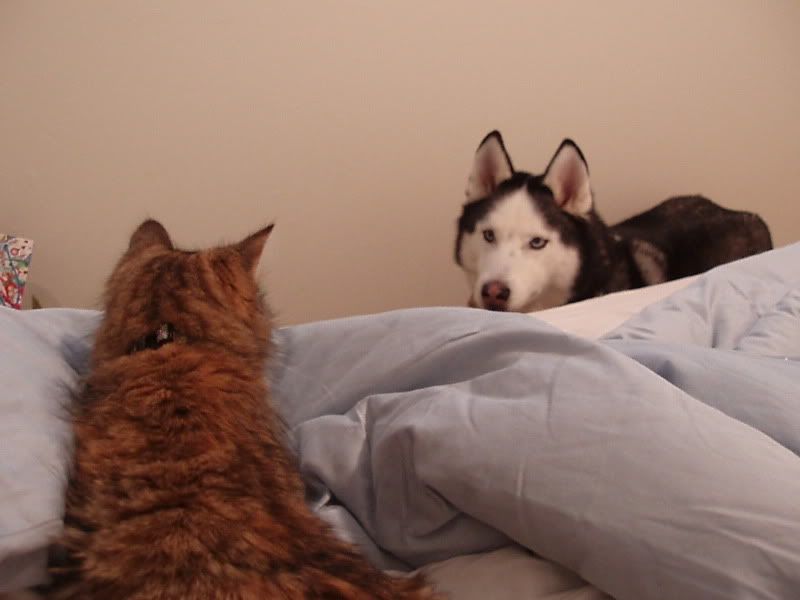 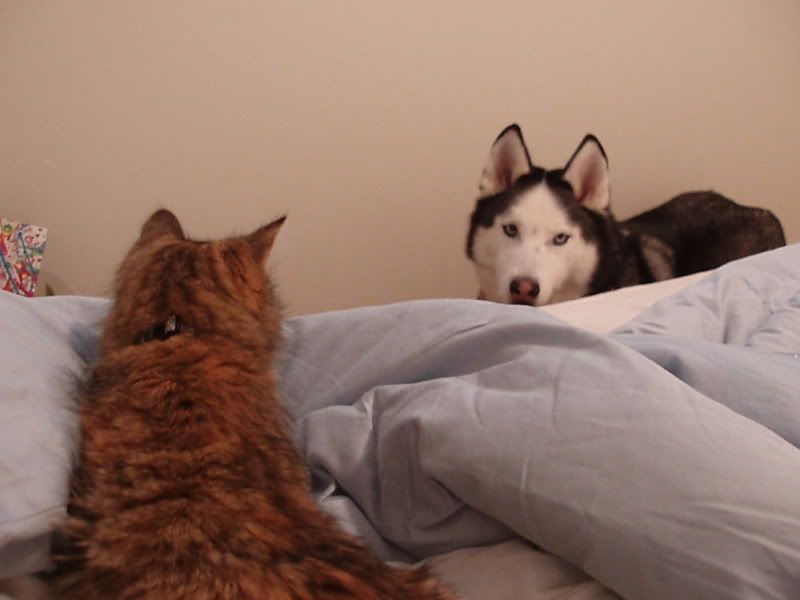 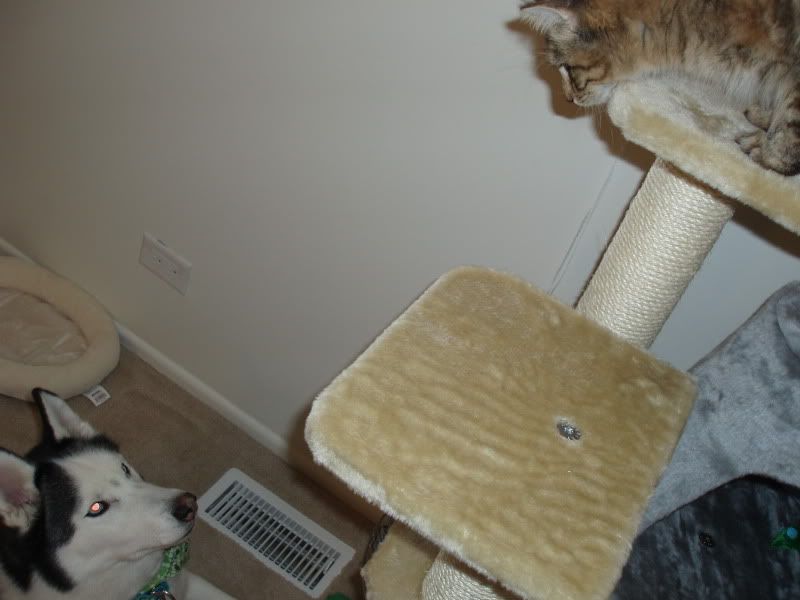 Learning to be good: 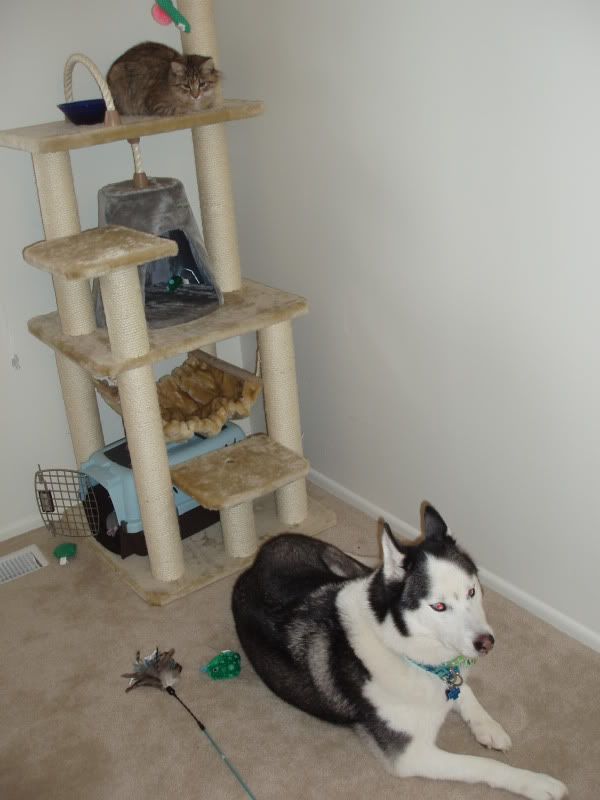 Like it's already been said, it depends on the dog, and it depends on the level of training. I would say from my experience, there is no breed in this group that is inherently better or worse with small animals (unless you consider sight hounds) but individual dogs will have different instincts. I'd say if you're worried about cats, your BEST bet would be to adopt an older dog who's history is known so you give yourself the easiest time possible. That said, it IS possible to work at training out prey drive (which you will ALWAYS have to do to a degree) but it takes a lot of work. Also, different dogs have different levels of prey drive, and a lot of dogs can never be trusted alone with cat for this reason. We had Buddy for about 3 1/2 years before we got our cat. In those 3 odd years, we worked on him with the random animals we saw on our walks. We got him used to the "No Chasing" command to where if nothing else, he understood the command and generally followed it. This command was invaluable when it came to getting the cat. When we brought her home, obviously she spent her first time locked away, then only short, supervised time with the dog in short bursts. This was the most important time for us with Buddy because we were able to reinforce the idea that he should ignore Kaipo. Any time he seemed like he might get excited around her, he was told, "Leave it, no chasing," and he caught on pretty quick how to be nice. After working on this awhile, he's totally fine with her now. The only thing he'll do is a correction bark/charge/whatever you want to call it that he would use with another dog, not a prey animal, so we let him "correct" her (unless he's out of line, obviously). It's totally possible to teach dogs to respect cats from puppihood, but it's important to remember that it will be a lot more difficult (as opposed to an adult who is known to be good with cats) because puppies need to learn EVERYTHING from scratch, so it isn't just the one behavior that's being worked on. However, if it's going to be your first dog, that's even more reason to get an adult. quote:3) Would it be really bad to get one if you haven't had a dog before, or are they OK if you do some research and have some idea of what to expect? paisleyfox posted:3) Not really, I guess. Koji is my first dog EVER. But I knew what I was getting into, I was involved in breed specific forums, hounded the rescue I now volunteer for, and played with my friends' Shiba, Dug, as well as my husband's Eskie, so I kind of knew what to expect attitude wise. Fostering, finding a local breed rescue, or a meetup group would be a great way to break into it. All of this! Buddy's technically my first dog, too! If I were you and considering ANY dog, I'd find some sort of group you could volunteer with where you could get lots of first hand experience. If there's a specific breed you have in mind, see if you can find a breed rescue or breed club in your area that would be willing to give you experience with the dogs. People in those sort of groups will LOVE that you want to get experience first, because they're the ones that see problems with impulse, "THEY'RE SO CUTE!!!" purchases. Overall, I'd say you need to have a very calm, confident attitude when it comes to these dogs. They need to know you're in charge and that things don't phase you. The SECOND they see you falter, they take advantage. Contrary to what a lot of people think, this doesn't mean you need to "dominate" them, yell at them, or constantly correct them, but rather they have to get the general sense that you won't accept any poo poo on your end, so they won't even bother. It's really a hard thing to explain, that's why getting to know other primitive breed owners is the best experience you can get.
|
|
|
|
paisleyfox posted:COWER AT THE MIGHT OF THE JAPANESE! hahaha I love when she finds the akita, "KAWAII!  " "
|
|
|
|
^^^a life less, that dog's beautiful! paisleyfox posted:No, you may absolutely NOT stand by the door when it is open until I say so. Get up and the door closes and we do it again. HA!! We fight that battle every day! Less so when Buddy's tired. paisleyfox posted:It is hard to explain, but if anyone has ever had first hand experience in a daycare or with young children, you will know EXACTLY what we are talking about. This just killed me, because it is SPOT ON. I always say I inherently know how to handle these dogs well because I take after my father. He's the type that would give you one look and you'd feel SO guilty that you would try so hard to be good.
|
|
|
|
Buddy's a dainty little flower, too. He doesn't like going out in the rain and god forbid the grass is wet. True to his breed, the only thing he doesn't mind is snow. My favorite story about how clean he is was when we went to visit my parents' one day RIGHT after my brother finished cutting the lawn. It was sorta when Buddy was still new, so I was planning on taking him around on his leash first, even though it's all fenced in, but my dad goes, "He's fine!" and lets him loose.  (side note, thankfully my brother heard jingling, he still had the fence open! (side note, thankfully my brother heard jingling, he still had the fence open! Really, the only reason I wash Buddy about 4-12 weeks or so is mainly for his shedding. The bath really, really helps get the undercoat out. Plus, it's as easy (and cheap!) as just taking him to work with me. 
|
|
|
|
Kerfuffle posted:Are spitz doggies generally good/bad with other dogs? I'm aware of Akita's gender aggression but not much beyond that. Sled dogs are generally pretty good with other dogs, actually, since they're bred to work in teams. The thing of it is, they're very pack oriented, so sometimes you can have clashes when two dogs who think they're hot poo poo get together. They tend to be pretty racist, too, in that they generally get along best with dogs who "speak" their language, so usually other pointy dogs who are really expressive. For example, Buddy has a hard time playing with my sister-in-law's dog because he's a Golden with VERY floppy ears, so I don't think Buddy can read his mannerisms well. So, really, as far as sled dogs are concerned, either you get an adult who's known to be good or bad with other dogs, or you raise a puppy on your own and socialize it so it's good with other dogs. But, yeah, they're not inherently dog aggressive (or people aggressive, for that matter).
|
|
|
|
Speaking of primitive dogs and cats, I forgot about this video until just now. http://www.youtube.com/watch?v=MdUmOd0KFeI&feature=related
|
|
|
|
hahaha Awww, it's awfully sad when he gives up. I don't know how you could stand boarding your dogs like that, I have a hard enough time leaving my pets with my brother who loves them and actually stays at the house. I know it's a normal thing to do, but I sooooooo miss Bud when I'm not here!
|
|
|
|
Zorak posted:I've got an Akita mixed with ~ something ~ and he is literally the best dog I've ever had. So loving chill, so loving sweet. Never has been aggressive or anything - most aggressive he gets is him butting in the way of any dogs fighting and just standing there in the way like HEY If nothing else, shepherds are bred with insane biddabilty, so they're much more likely to listen, and you (in theory) would have a much easier time with training and the dog actually listening to commands. It's a good reason people should consider adopting mutts if they're interested in primitive dogs but are intimidated by their temperament. 
|
|
|
|
CarnivorousThing posted:But she wasn't as aloof as any of the primitive breeds so I guess her other genes included Retriever and Beagle. To be fair, there are a lot of primitive/spitz dogs that are super friendly. Huskies in particular are super social, but most sledding breeds are the same way. They're bred so much to work with people and work in a group that they're generally excited to see anyone, contrary to their Asian/pariah brethren.
|
|
|
|
Yeah, I could definitely see her as a husky/retriever/godknowswhatelse mix.
|
|
|
|
That dog is so awesome! 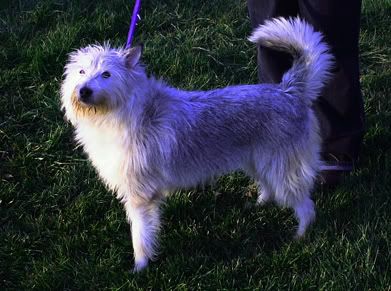 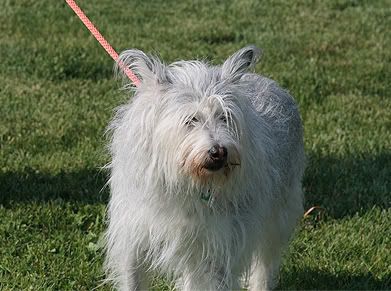
|
|
|
|
That first one has been there a lot longer, I think she never got adopted out in the first place.  But since she's been at the shelter so long, she's been groomed regularly since the head of the rescue is a groomer. But since she's been at the shelter so long, she's been groomed regularly since the head of the rescue is a groomer.
|
|
|
|
Wolves: Close Cousins to Primitive Breeds As we’ve already mentioned, Primitive Breed dogs are scientifically shown to be, out of all purebred dogs, those closest genetically to wolves. Because of this, when considering any sort of Primitive Breed (whether you already own one or are considering one) it’s important to look at wolves, their behavior, and how it both differs from and influences dogs. Last year my husband and I went to a seminar on wolf and dog behavior at Wolf Park in Indiana. After taking a crapload of notes, I wrote up a whole post that a few good samaritans were nice enough to pull up from the archives for me.  Since I REALLY don’t feel like typing out all this info again, here are some of the more important parts about wolf behavior. I know it might seem odd to have such a large section on just wolves, not dogs, but not only is this a great way to look at raising Primitive Breed dogs, it’s also a lead in to some other fun discussion later on. Since I REALLY don’t feel like typing out all this info again, here are some of the more important parts about wolf behavior. I know it might seem odd to have such a large section on just wolves, not dogs, but not only is this a great way to look at raising Primitive Breed dogs, it’s also a lead in to some other fun discussion later on.  WolfensteinBag posted:The first lecture of the day was about the domestication of the dog, and how they came about. It covered wolf and dog genetics, mentioning how aside from slight variations, they are genetically identical. Up until they started doing the research that they use now to differentiate different breeds of dog, you could send a sample of any dog's blood along with a sample of a wolf's blood to a lab, and they wouldn't be able to tell you the difference. Where wolves and coyotes, for example, are genetically and specifically different species, wolves and dogs are not, which is very interesting. WolfensteinBag posted:As the pups get older and start moving towards adolescence, they start pushing their boundaries and seeing where they might fit in the pack. If it's a small litter, you can see very early on which pups are likely to be dominant, and which ones are submissive, but with larger litters, it can be hard to tell until they're older. Once the pups start getting older, their play fighting also starts to have a purpose, and before long the adults are no longer "tolerating" their BS anymore, and actual pack structure starts to develop. I’ll leave this for now, but it’s an important lead in for things to come! Wolf Hybrids and New, Wolf-like Dog Breeds! WolfensteinBag fucked around with this message at 15:20 on Sep 8, 2010 |
|
|
|
paisleyfox posted:Also, I love everyone's dogs. haha I know!! I love that all these awesome dogs are coming out of the woodwork now.
|
|
|
|
That dog is SUPER awesome. RizieN posted:Also, about the wolf thing and dog evolution, what were dogs like Jack Russel terriers and Beagles doing before domestication, are they a product of domestication? Did they evolve into their current breeds from the wolf and/or human's cross breeding them? Are all dogs descendants of wolves if you trace it back far enough? Yeah, those types of dogs didn't exist before human intervention.  All dogs are decedent from, and related to, wolves, however. I actually just posted a bit on this, the wolves that weren't afraid of human camp sites realized they could score easy meals if they stuck around. So their flight response lessened while the traits they needed for hunting also lessened. After a bit, people realized dogs could be useful and started actually breeding them for a purpose. Dogs that are far removed from wolves (like the jack russels and beagles you used as an example) are the products of years and years of artificial selection to breed for useful traits. So, yeah, any wild dogs are/were more likely scavengers than dogs that would actually hunt in packs. Small game like rodents or rabbits, if anything. All dogs are decedent from, and related to, wolves, however. I actually just posted a bit on this, the wolves that weren't afraid of human camp sites realized they could score easy meals if they stuck around. So their flight response lessened while the traits they needed for hunting also lessened. After a bit, people realized dogs could be useful and started actually breeding them for a purpose. Dogs that are far removed from wolves (like the jack russels and beagles you used as an example) are the products of years and years of artificial selection to breed for useful traits. So, yeah, any wild dogs are/were more likely scavengers than dogs that would actually hunt in packs. Small game like rodents or rabbits, if anything.Fake Edit: Yeah, Rixatrix, regardless of function or breed classification, Lapponian Herders would be a primitive breed.  Like it was mentioned in the main post, it's more to do with how closely related the dogs are to wolves, as opposed to when or where they were bred and for what purpose. Anything spitz-like is going to fall in that category. Like it was mentioned in the main post, it's more to do with how closely related the dogs are to wolves, as opposed to when or where they were bred and for what purpose. Anything spitz-like is going to fall in that category.  Also, tail curling *technically* has nothing to do with whether or not a dog is primitive! Wolves themselves don't even have any curl to their tail, it's definitely a dog trait as opposed to a wolfy one.
|
|
|
|
rivals posted:Kaidan photo dump! Rixatrix posted:How long does it take for your dogs to finish shedding? I think Rho shed (well more than normally) for about a week, but Pi manages to find undercoat to push out after five weeks of furminating and vacuuming. Well, lets see... Buddy probably started molting around March, got really bad around April/May, and he had just finished some time near the start of July. Part of his problem is our A/C in the summer. It gets to be boiling outside (especially this year for some reason, in the 90s most of the time) and we're big sissies AND we got central air for the first time this year, so we've been BLASTING it and keeping it pretty drat cool in the house. Buddy never quite got his nice, sleek summer coat this year, even at his lowest, it was still pretty puffy. Now that he's shedding again so early, my guess is he's going to go through two winter coats as well.  He'll likely grow a little bit of a thicker one for fall, then I'm guessing around December he'll blow coat again because that's when the temperature really starts to drop. Then in January and February we should FINALLY get a small break because the temperatures will be in single digits. Provided we MAKE him build up his tolerance (which we generally do, so he can still get exercise) he'll grow in a nice, thick, puffy coat that I'll regret making him grow come spring. He'll likely grow a little bit of a thicker one for fall, then I'm guessing around December he'll blow coat again because that's when the temperature really starts to drop. Then in January and February we should FINALLY get a small break because the temperatures will be in single digits. Provided we MAKE him build up his tolerance (which we generally do, so he can still get exercise) he'll grow in a nice, thick, puffy coat that I'll regret making him grow come spring.
|
|
|
|
pandrax posted:Here are a few of the videos I put on YouTube of Jolly. I just want to mention that it looks like there's some pretty dangerous stuff going on with Jolly's behavior that you're probably unintentionally encouraging. Obviously, I'm talking about the videos where he's growling and correcting you. You shouldn't allow him in situations where he can do that, and especially shouldn't try to appease him like you are. Particularly, in the video with the toy, I'm pretty sure you're trying to keep him calm, but when you say, "Good boy" and praise him, you're also backing off. He thinks he's doing right by protecting his toy and growling at you. You also shouldn't allow him to be so aggressive around your girlfriend like that. Your girlfriend is not his to possess. Nothing is, you need to establish that good things come from you, and only if he's being good. You should look in to NILF training (Nothing In Life is Free) as it's a great system with primitive dogs. Your dog needs to have more boundaries than he does, it seems like he's been given a lot of leeway (which is a common mistake with primitive breed owners) and has taken it upon himself to "rule" the house as it were. You want him to work for everything he gets that he wants, like food, treats, toys, going outside, etc. He needs to do things like sit and be patient, lay down, or do tricks. He should not be allowed on the couch (as much as I'm sure you love cuddle time) because he's claiming the spot (and your girlfriend) as his own. Toys shouldn't be just up for grabs, they should only come from you, and should be taken away easily. If your dog is GOOD about letting you near his toy, you should praise him like crazy and give him some treats to show that by letting you take his things, he gets even BETTER things as a result. You shouldn't tolerate or just "live with" aggressive behavior just because of where your dog came from. Although it may be more natural for a semi-feral dog to act that way, he's still a dog, and he was still raised from a young enough age that such actions should be able to be managed with proper training and structure at home.  Kiri koli posted:Awesome American Eskimo That is such an awesome doggy! 
|
|
|
|
a life less posted:What a gorgeous dog! What do you think I've been working on? (and by working on, I mean having info sitting around that I haven't been able to coherently compile yet... Edit: Damnit, Rivals, you're too fast.
|
|
|
|
RizieN posted:I'm still waiting on Wolves Part 2 : hybrid boogaloo YES! That is SO going to be the title now.  I promise I'll get it done, though! I promise I'll get it done, though!
|
|
|
|
Sock Weasel posted:Basically he's an 8 month old Vlack / Czechoslovakian Wolfdog who I will definitely give you guys a write up of once I'm not half asleep pandrax posted:Since you commented back, I've gone full out with the NILF training. It works and it works fast. I'm having a harder time explaining to roommates and guests, than training Jolly to be in line. Spoiling him, or letting him get away with stuff (even if it's just for the camera) made him pretty unmanageable at times. I spent the last couple days with a water bottle and a bag of treats, and it made a big difference. I just wanted to update on that. The couch thing needs to be worked on - we seldom let him in but he does go straight to the couch. He sits before I give him a bowl of food (usually without telling him to, and if he doesn't sit, then he doesn't get anything until he does). I find him at his most unreasonable if he hasn't eaten in awhile. I hid all of the toys and he won't get most of them back for awhile. In the past I've found most of the backyard drama between the two dogs has been over rawhide and bones - so I'm cutting those out completely and just going to use treats that will be gone fast instead of something that he can be aggro/possessive over for hours to days. That's fantastic!!!  I'm so glad to hear it's working out! You'll have to keep us updated with your progress, you really have a couple of awesome dogs, there. I'm so glad to hear it's working out! You'll have to keep us updated with your progress, you really have a couple of awesome dogs, there. 
|
|
|
|
Ooooh, you definitely do have your work cut out for you finding a dog in the UK. With all the problems with the breed there, no one even wants to sell to the UK, so even good breeders are having a hard time finding dogs.  Are you ever in the forums there? That's the only other place I hit up as much as PI. Are you ever in the forums there? That's the only other place I hit up as much as PI.  Oooh, just looked up your dog, I knew Fergus sounded familiar! He's actually from a good line, I love the breeder of his mother. I swear I recognize the name, too, I think whoever his owner is posts in the forums. It's a shame the dogs aren't FCI registered, though.
|
|
|
|
Random Buddy photo dump! We're going to have to have a contest for smallest husky ball. 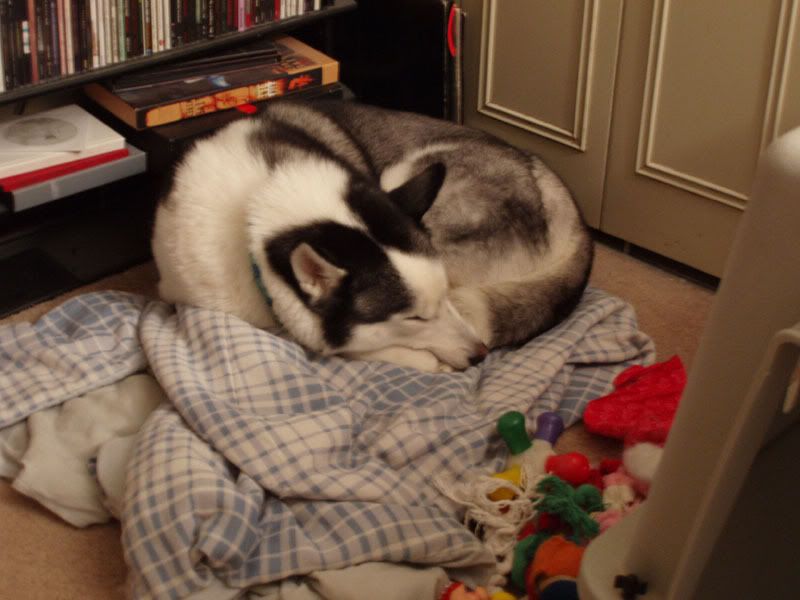 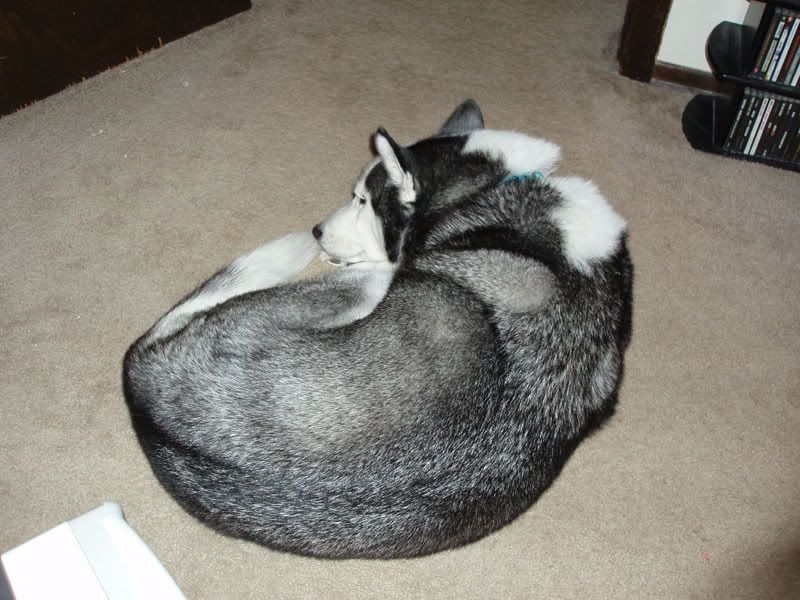 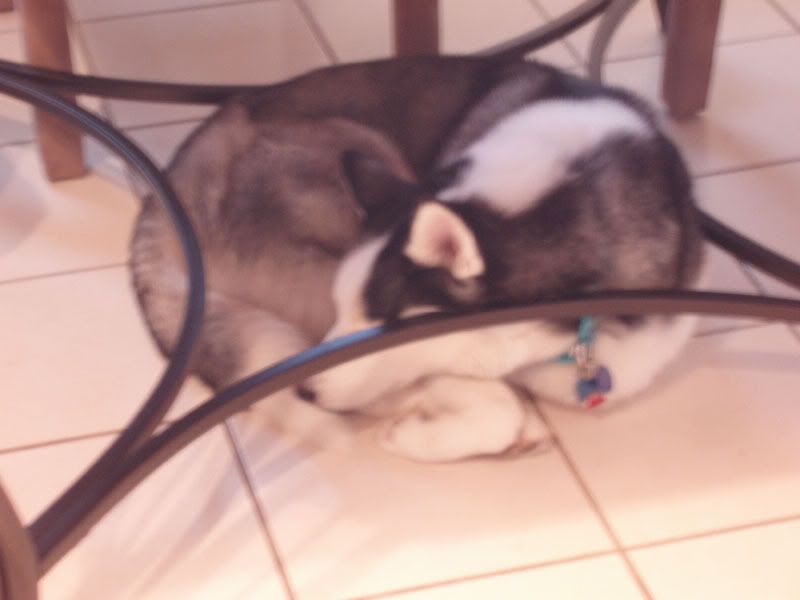 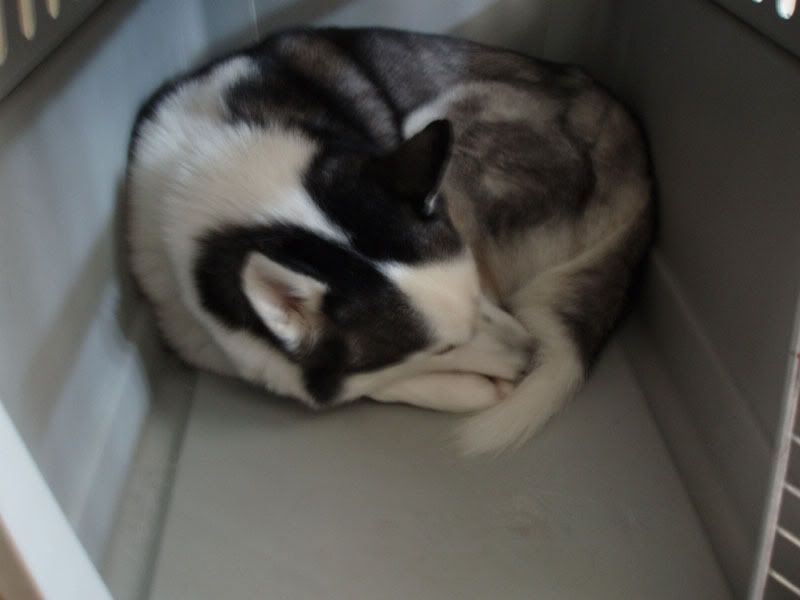 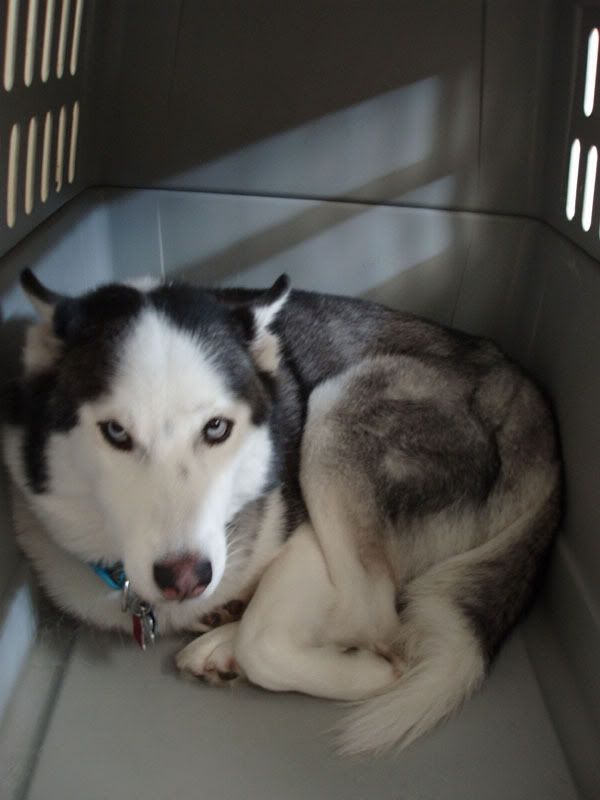 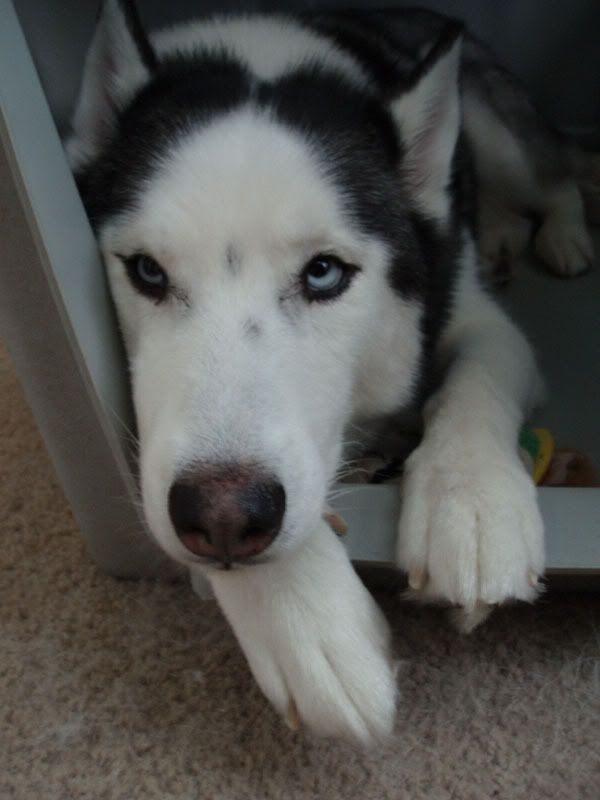 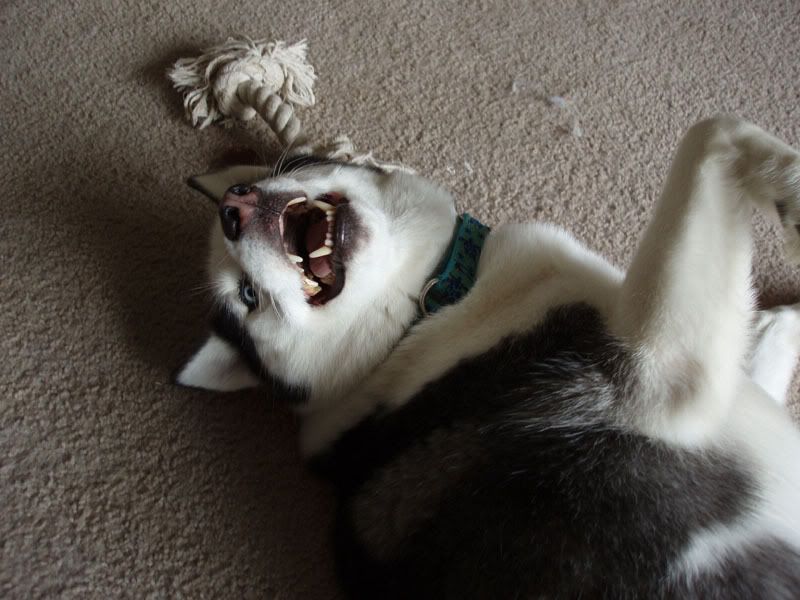    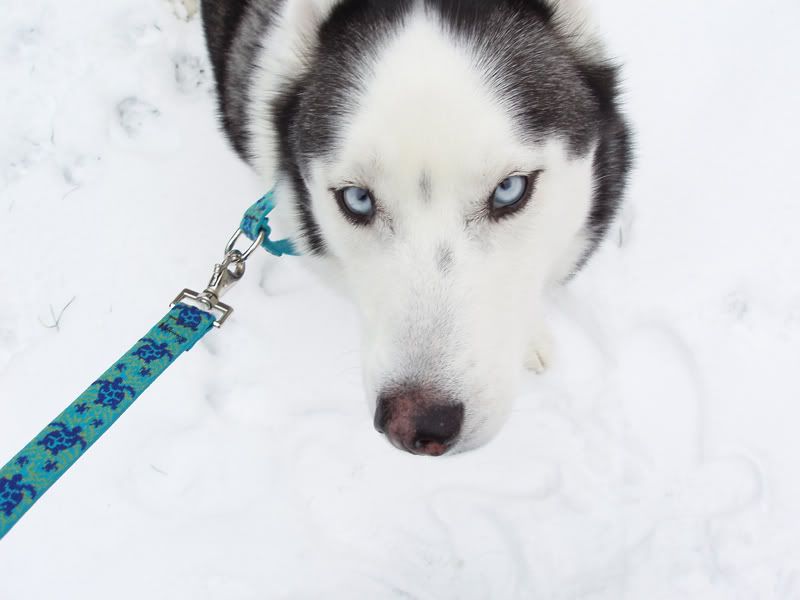 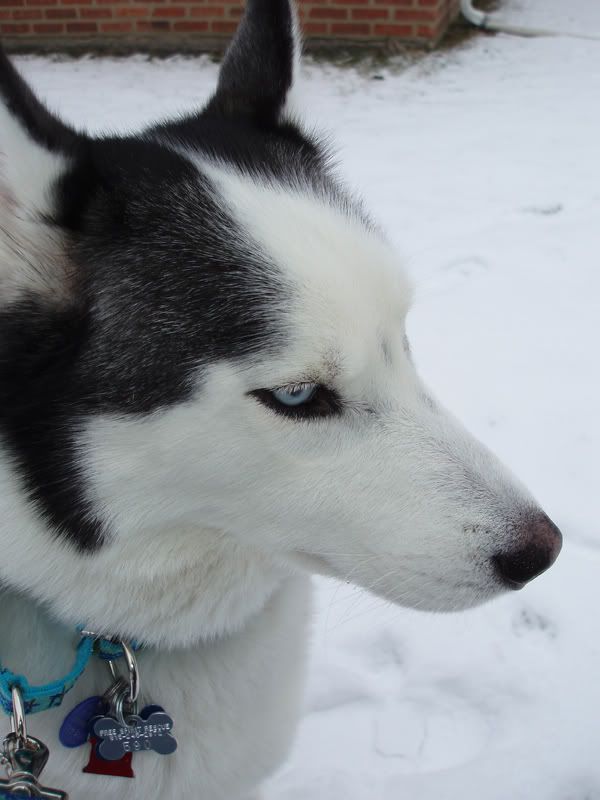  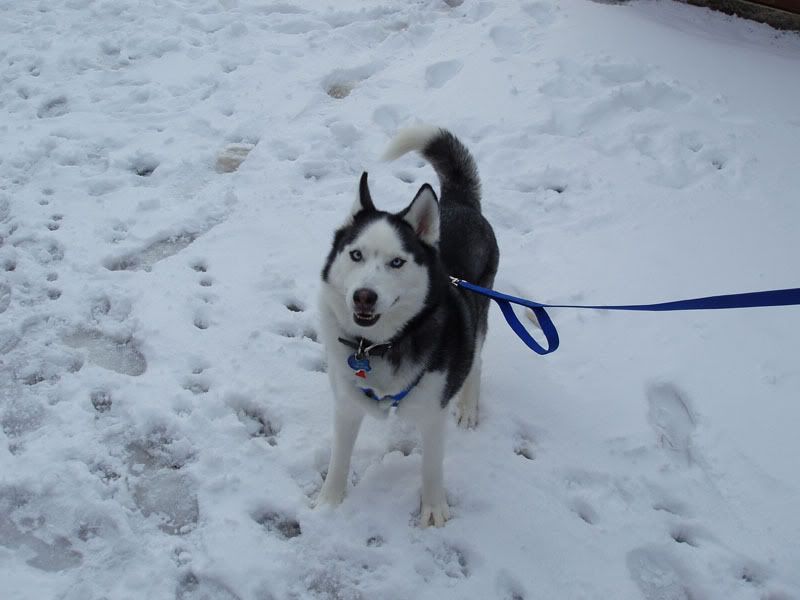  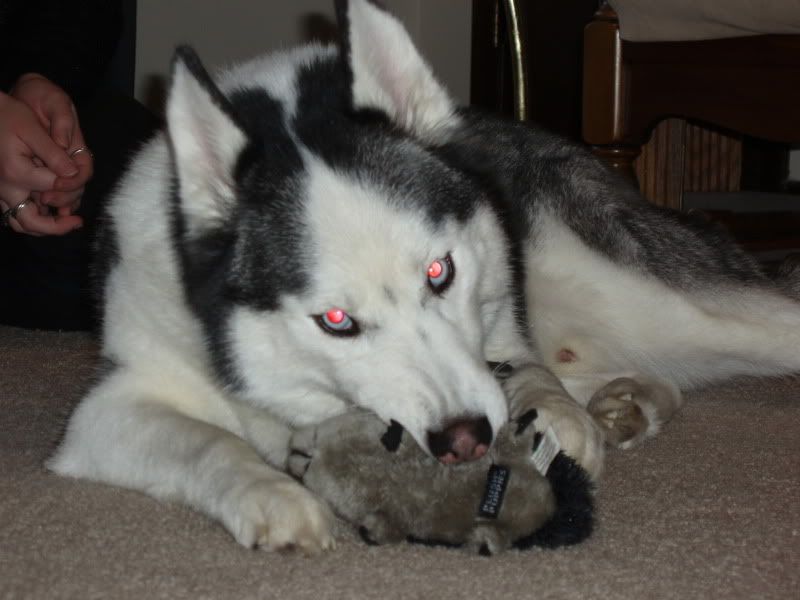 Here's what was on the website that made us want to meet Buddy 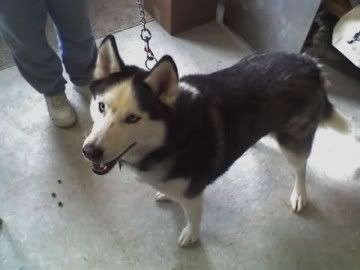 These were all some of the older pictures I had, since I haven't posted them in a long time. There's tons more where that came from, though. Also, here's a link to our channel on YouTube, there's a bunch of other random stuff, but there's a TON of Buddy videos on there. http://www.youtube.com/user/randomwordcombinatio?feature=mhum#g/u
|
|
|
|
hahaha Koji cracks me up. I  Shibas. Shibas. Kerfuffle posted:I just wanna pet your dog wolfstein he just looks so fluffy and he's so cute. If you're ever near Chicago, just let me know! Sock Weasel, thanks for posting Hrafn!! It's so funny, he totally has his mother's face. Do you by chance remember who Fergus' owner is? I KNOW it's someone who posts on wolfdog.org, but the database is still somewhat down (no owners are listed) and it's KILLING me that I can't remember who it is. Also, feel free to post more pics!!! CsVs are a novelty around here, obviously, you're the first person on SA who's come forward owning one. I'm planning on getting involved with the breed down the line, ideally starting a kennel, so I absolutely love seeing pictures of them.  Oh, also, I sent you a message on wolfdog.org, but I just realized you're fairly new here, and you might not have gotten the reference. Oh, also, I sent you a message on wolfdog.org, but I just realized you're fairly new here, and you might not have gotten the reference. 
|
|
|
|
Wolves Part 2: Hybrid Boogaloo ”It’s a Great Idea! Didn’t you read White Fang?” Wolf Hybrids and Why You Really Don’t Want One “So, I can’t own a wolf so what about a wolf hybrid? It can live in the house and be *~*my companion*~* not my slave!” Honestly, this is a huge reason people list for wanting a hybrid. Also, “I’ve always felt such a BOND with nature,” and “I’ve always just had a natural understanding with animals.” The FIRST thing you need to ask yourself is, “Why get a wolf hybrid when there are so many breeds that are similar to wolves, and much safer to own?” While you mull that over, we’ll go over what hybrids actually are, what the community is like surrounding them, and what people in that community consider to be a “good” hybrid breeder*. *I’d like to take a moment here to do an aside on this topic. I’d like to point out that with these dogs, the grey area of what you’d consider a good breeder gets even broader. All I can do is point out how people involved with these dogs see breeders, and it’s VERY important to understand that all these people are PRO hybrid and actually own these dogs, so it’s likely their views are bias in that direction. When I mentioned that while I'm doing research, I will likely never own a hybrid myself, I actually had someone reply, "That's a shame." The most important thing anyone reading this can do is to take in the facts and compare them to your personal ethics on breeding to decide where you feel on the subject. Just know when I write this, I’m not condoning anything, I’m just posting what I’ve learned.* One of the first things you’ll learn if you do any sort of research into wolf hybrids is that it’s apparently become politically incorrect to call them as such. The term “Wolfdog” has been favored as of late for two reasons, 1) The dogs technically aren’t hybrids because wolves and dogs are the same species, and 2) “Wolfdog” just sounds better when dealing with the general public. A wolfdog, however, is a very general term encompassing a wide variety of dogs. Wolfdog can mean a 50/50 mix of a pure dog and a pure wolf, it can mean a dog that has a wolf in its far ancestry who’s pedigree is mostly dog, or it can mean the opposite, a dog who mainly has wolf in it’s pedigree, but has just a drop of dog to make them still legal to own (in areas where it’s legal to own hybrids). Overall, dogs can be further categorized into High Content (mostly wolf, and must be approached and housed as such), Mid Content, and Low Content (or “Low-No Content” when the dog is claimed to be a wolfdog, but it exhibits no real wolf traits). Responsible owners of hybrids stress the fact that since these dogs are all over the board in terms of content and the dogs they’re mixed with, it’s vital to do research before owning one. It’s important to understand wolf behavior and containment (in case the dog winds up unfit to live indoors and must be kept in an outdoor environment with at least one other companion wolfdog), “wolf-like” dog breeds that are commonly mixed like huskies and malamutes, and to a lesser extent, GSDs, and how these traits can mix. Wolfdogs should be trained and treated as wolves, since typical dog training methods simply do not work. It is extremely important to build up a bond with your dog and understand that there are a lot of wolf-like instincts, such as prey drive, that may never be trained out. Here’s a link to Wolf Park’s Guide to Keeping Wolves and Wolf-Hybrids. It has a lot of fantastic info on the dedication it takes to keep these dogs. As far as reasons for breeding and finding a responsible breeder, I got a lot of responses that boils down to the fact that the reason there isn’t an American Wolfdog breed the way there is a Czechoslovakian Vlcak (Wolfdog) is that specific breeders have different goals in mind, so it’s important to find a breeder that shares your vision of the “perfect” wolfdog. While specific goals may differ, it seems there are a few things that draw people to these dogs that good breeders will take into account when breeding. First and foremost should be health. I got a lot of people talking about breeding these dogs because wolves are naturally more healthy because they haven’t been so horribly inbred, and so they breed wolfdogs to essentially bring “new blood” back into old lines. Good breeders actually do keep track of pedigrees very closely and will only breed dogs who have a clean health history. There are even breeders who will register their dogs with OFA, however it seems most people are more “old fashioned” in that they just track whether health problems arise as opposed to actually testing. In addition to just tracking health, a good breeder will be able to look at dogs with a critical eye and be able to pick a sire and dam that are suitable to one another physically. Breeding two dogs who are drastically different will result in a wide variety of pups and will never “breed true”, regardless of the aim of the breeder. Also, small faults can be possibly “fixed” by breeding a similar dog with a much better structure in regards to the fault. This is really true of ANY dog breeding, and should be taken into account to matter what breeder you’re looking for. In regards to specifics, honestly I’d say the majority of breeders are really just looking to breed companions. This flies in the face of a lot of what is commonly known as “good” breeding (as in, breeding for work or confirmation) so one must be very choosey in picking a breeder. Some breeders aim for a high-content dog that acts and looks almost identical to a wolf, aside from their papers. It’s commonly understood in the wolfdog community that these animals are best left to people with tons of experience, and that it’s better to own Low-No content dogs first and “work your way up” to higher contents. Some other breeders are looking to breed pet dogs similar to the sledding breeds used, but are healthier because of their more diverse genetics. Still others actually will breed for work, whether it’s something like service dogs to bring into hospitals or nursing homes, or more actual work like Search and Rescue or Drug Sniffing. Amusingly enough, studies have shown that wolves in fact have a better aptitude for scent trailing which makes wolfdogs ideal for this type of work. All in all, it is vital to do research before even considering one of these animals, or you could wind up with a huge problem on your hands. It’s also important to get tons of experience with other Primitive Breed dogs so you have more of an understanding of the temperament you’re going to face. Wolfdogforum.com is a fantastic resource for anyone interested in these dogs as most of the members own wolfdogs of all different content and have tons of experience with them. They’ll also admit that pretty much all of them have been lied to about percentage in their dogs, so they know what to look for in a good breeder, and have reputable ones they can recommend (and know bad ones by name). Wolf Park also has a fantastic page with tons of info on wolfdogs/hybrids. A lot of the links are unfortunately broken, but there is still a lot of great info. Also, be sure to check out their articles. Speaking of percentages, that’s the last thing I’d like to bring up. Basically, everyone involved in these dogs is OBSESSED with figuring out percentages of “wolf blood” in their dogs. They do all sorts of complicated math to figure it out and use that to determine content of their dogs. Truth be told, however, percentages are all completely bunk. Based on variation in genetics, littermates can be so drastically different that people familiar with the breed will “identify” them as being different percentages if they were only shown pictures and not told the dogs were related. This is part of the reason it is VITAL to do research and understand that if you are unable to handle a wolfdog at its worst, it is irresponsible to own one even if you believe it to be a lower content. When all is said and done, there is little to no “sure thing” with these dogs since there is no standard for them to breed true to. They’re a bit like the Labradoodle of the Primitive Dog world- you may end up with exactly what you want, but you may also end up with the exact opposite. Wait a minute… You’re STILL considering a hybrid?? You Don’t Need a Wolfdog If… This is a fantastic thread on Wolfdogforum.com. The title’s pretty self explanatory, and I feel it’s necessary reading if you aren’t already deterred. Here are some picture references regarding "Percentages" Dog that would be considered Low Content: 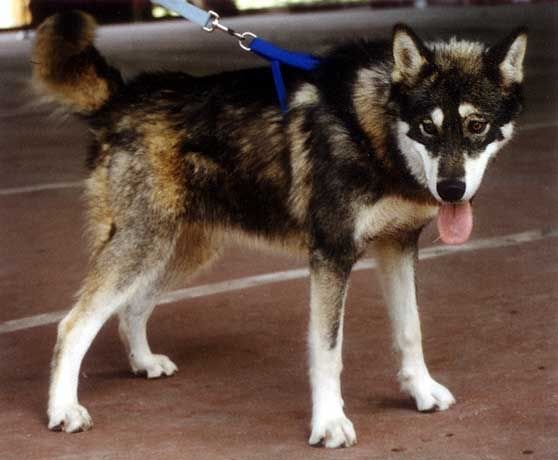 Dog that would be considered High Content (supposedly 1/8 Great Pyrenees, if you could believe it!):  The following dogs are examples of how percentages are just useless. It's far better to judge based on outward appearance (it's generally understood that a wolfy looking dog will act more wolf-like, regardless of content, and the same is true for more "doglike" hybrids) rather than whatever number is on paper. These two dogs are both 50% on paper. The first was, for the most part, a good housepet, where the other was not: 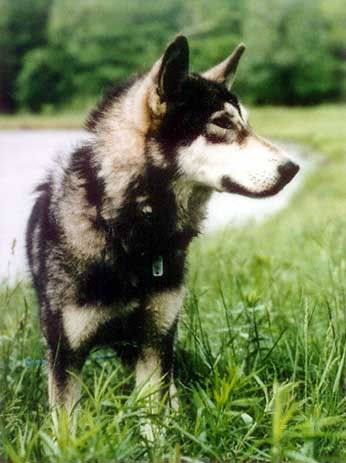 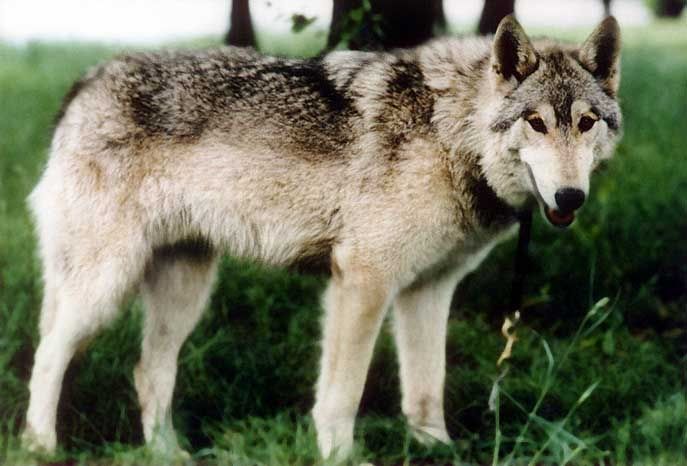 These two dogs are actually littermates. Once again, the more "wolflike" dog was much harder to handle: 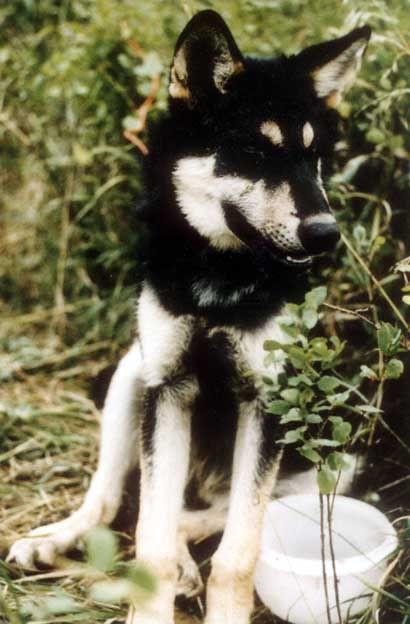 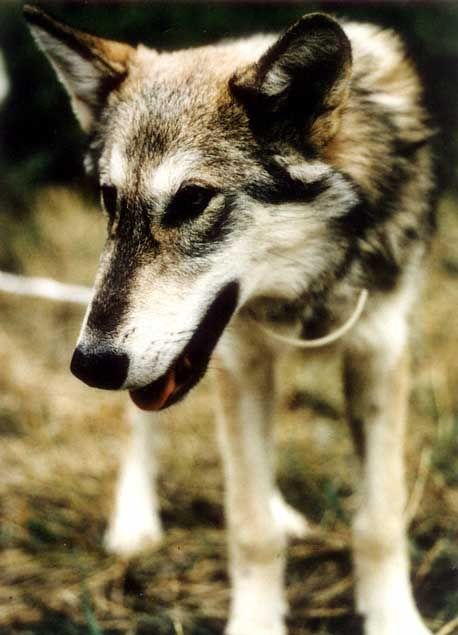 I'm guessing the final installment (including Czechoslovakian Vlcaks, Saarloos Wolfhounds, Tamaskans, and Northern Inuit Dogs) will be finished tonight since I have a lot of time, but I'm not making any promises to you heathens. EDIT: I forgot a really great resource, a bunch of info compiled about every aspect of owning hybrids. 
WolfensteinBag fucked around with this message at 01:13 on Sep 15, 2010 |
|
|
|
paisleyfox posted:Way to make me look inadequate, Wolf! hahaha I don't mean to make you feel bad!!! I've just been trying to blow through this stuff so I can get to my CsVs Also, happy anniversary!! quote:So, uh...Here's a picture of Hachi to let everyone know I have been working on it. And how loving cute he was. Oh man he is SO cute. a life less posted:There's a big-rear end Husky at my dog park (female, named Marlo) who the owner has mentioned is part wolf. The dog is freakishly large (but no larger than the other freakishly large Huskies at the park) and has a huuuuge stubborn streak, but is at its core "just" a dog. I love how just about any gangly primitive looking dog is at least "one-eighth wolf!!!11". hahaha I know!! People mention that a lot in those forums, that's where the "Low-No Content" came along. When enough generations go by, they really are just considered dogs (as in the case with CsVs) but unfortunately, awesome wolfy-looking mutt dogs aren't nearly as "cool".  It's really unfortunate because a lot of really great dogs wind up being put down because of their supposed "wolf content." It's really unfortunate because a lot of really great dogs wind up being put down because of their supposed "wolf content."  quote:Great post, WolfBag. You did a great job. Thanks!!!  quote:ETA: Also, I think it's interesting that you mentioned that the more "wolfy" looking hybrids tended to have the more wild temperaments. It makes me wonder if this mirrors the same things that happened in Russia during the silver fox study -- the foxes bred for softer, friendlier temperaments adopted more dog like features and coloration, where the more wild ones maintained their wilder appearance. The study suggests that the gene tied to the prolonged puppyhood most dogs experience is also tied to coat colour, ear carriage and tail shape. Yeah, that study is most definitely tied in. I agree, all of it definitely is interesting, and why so many geneticists are so curious about dogs and domestication of the wolf. 
|
|
|
|
Ok, so I'm definitely not going to have the rest of that stuff finished. Also, PFox, I'm really only getting through all this because it's been on my mind lately and a friend of mine posted this on facebook this morning.
|
|
|
|
Sock Weasel posted:If Hrafn ends up having good hip/elbow/eye scores a few years down the line we might consider having him sire a litter; there is a female his age up in Scotland who is from completely new bloodlines compared to the rest of the UK CsV's, which would be wonderful for the breed over here, but we'll see. If you do decide to go this route, please, please go hang around those forums a ton and get some advice from people that are really into the breed (I also left you a PM over there  ). Breeding isn't just about good hips and bloodlines, it's also about making sure two dogs are good matches together and will help eachothers' faults. It's also important to breed great examples of the breed, especially since you're in the UK and like you mentioned, you don't have a lot to work with there. I know you're saying you're shunned out because of where you're from, but they are really great if you're dedicated to the breed and making great choices and you will be able to find help. You're going to want to study the breed standard and really get a good eye for the dogs. Even though the breed is young, it doesn't mean it's a "go" to breed lots of litters, if anything you have to be MORE selective to make sure you're doing the best for lines in the future. ). Breeding isn't just about good hips and bloodlines, it's also about making sure two dogs are good matches together and will help eachothers' faults. It's also important to breed great examples of the breed, especially since you're in the UK and like you mentioned, you don't have a lot to work with there. I know you're saying you're shunned out because of where you're from, but they are really great if you're dedicated to the breed and making great choices and you will be able to find help. You're going to want to study the breed standard and really get a good eye for the dogs. Even though the breed is young, it doesn't mean it's a "go" to breed lots of litters, if anything you have to be MORE selective to make sure you're doing the best for lines in the future.  I know he's still young, but do you have any stacked pictures of your dog? Also, make sure not just your dog has good hips and elbows, but also check the lines he's coming from. I know his mother has a "C" hip score, and Fergus' score isn't on the database, so you're going to have to do some digging to make sure the lines are healthy. Check siblings, parents, grandparents, aunts & uncles, etc, and work your way back. You'd also really want to consider testing for DM and Dwarfism. 
|
|
|
|
paisleyfox posted:I could stare at this picture for forever. They look like cartoons~! hahaha I was going to say something along those lines, that picture is fantastic. :iamafag: Sock Weasel posted:
hahahaha Thanks for the effort! rivals posted:As far as NI's go, I think they are pretty much a wreck everywhere Yeah, the NI part is pretty much going to be a longer version of, "They're a joke, don't buy one."
|
|
|
|
stabbity posted:Now I own a dog who most people assume is a wolfdog, but I highly doubt he is. I do think he has some Chow in him, but he doesn't really have any of the primitive temperament at all. I have no idea what he is, really, other than a GIANT DORK. He looks a lot like a GSD, except his muzzle is a bit off. I wouldn't be surprised if he were mostly GSD with just a "splash" of something else like akita or lab, especially if he has a better temperament. He's super handsome, though. It's a shame about your family's dogs, and I don't mean any offense by it, but that sort of stuff is exactly the reason people have to be careful with wolfdogs. For one, there are a LOT of people who breed their dogs almost just because they need something to do, and people lying about content is rampant with BYBs (not your parent's necessarily, since you didn't say it, but seemed to fit with the topic). Also, your mom's friend not being able to keep her dog is a great example of how people get these dogs with zero understanding of what they entail. I mean, hell, people tend to get ANY Primitive Breed without knowing what they're getting in to, getting a dog with actual wolf content is so much worse. It's really a shame (in my opinion) that these dogs are becoming so popular, because there are vastly more bad breeders than there are decent ones, and 99% of the public is not equipped to handle them. So, yeah, on a completely different note, I totally forgot to work on those other breeds last night.
|
|
|
|
 I can't wait for your post! I can't wait for your post!
|
|
|
|
”Is That a Wolf?” New Wolflike Dog Breeds ”So I can’t own a wolf, and I shouldn’t own a hybrid… what the hell CAN I own?” There’s no denying that wolfy looking dogs are freakin’ adorable. Naturally, there is an appeal to these dogs so people are constantly looking for dogs that are more and more wolfy. While getting a hybrid is risky, there have actually been a number of breeds developed in recent generations that are very wolfy-looking, but actually are registered dog breeds or at least have their own breed registration/tracking. Even though these are all breeds that have their own standards and breed clubs, some are better than others in terms of suitability for homes, the breed actually breeding true, and reputable breeders. All of these breeds differ for various reasons, so like anything else, you should do a lot of research before diving in and buying one. Czechoslovakian Vlcaks  This is by far my favorite breed, so I’m going to be very bias and write an awful lot about them. Nowadays, these same ideals are in place with CsV breeding. The breed is recognized by the FCI along with various other registries (including full registration in the UKC in the US, along with AKC Foundation Stock registration). One of the most amazing things about the breed is that every dog’s pedigree has been tracked back to the foundation stock of 2 wolves and about 20-30 GSDs. This amazing database has allowed for careful tracking of breeding to ensure genetic diversity and careful tracking of health issues (taking particular note of issues that commonly face GSDs). This allows breeders to develop particularly healthy lines and also to find suitable matches from all over the world. It also (as of the last update) flags you as to whether dogs are unregisterable with the FCI and whether they actually come from mixed origin so it’s much easier to see where the particularly bad breeders are. Although the CsV does indeed have wolf content, these days it’s considered a dog breed “with recent wolf addition” as opposed to an actual hybrid, and are completely legal to own. They are indeed mainly dog-like aside from the typical characteristics you would find in any Primitive Breed dog, but they still aren’t an “easy” breed to own by any means. They are working dogs and need to be treated as such. A good description of what they’re like would be a high drive, working GSD, with a husky’s thought process when following commands. This actually lends itself well to Search and Rescue work, especially since it is so similar to the CsV’s original function of trailing. Other CsVs are also working in Schutzhund, police/military work, rescue work, and even mushing. Most CsV owners will just do whatever job their particular dog prefers to do, without focusing specifically on one task and breeding for that. Here is an excerpt from the Proposed Breed Standard for the AKC regarding temperament: Standard Temperament posted:Temperament. The Czechoslovakian Vlcak is confident, lively, active, tough, obedient with quick reactions, suspicious, fearless and courageous. The Czechoslovakian Vlcak shows tremendous loyalty towards his master. The Czechoslovakian Vlcak is resistant to weather conditions, and possesses the capability of great endurance. An aggressive or overly shy dog must be disqualified. A dog with faults in demeanor and temperament must be disqualified. Right now, the breed is extremely young in the US. As of right now, the only active breeder (who has produced the first and only litter in the US) is Marcy Goldstone of Galomy Oak in Virginia. There is at least one other person looking to start a kennel down the line that’s actually close (Jason Young, Americani Kennels) and the owner of the only female from Galomy Oak’s first litter is planning on breeding down the line as well. With such a young breed, it is important to import as many dogs as possible so a broad genetic base can be established, avoiding bottle necking that has happened with so many breeds (including GSDs) in the past. For more info on CsVs, the best place to look would be the Wolfdog.org Forums. With forums including a whopping ten different languages, it is a worldwide group of breeders and breed fanciers that I’ve not seen anywhere else. For more contacts in the US, you can also visit the Czechoslovakian Vlcak Club of America (CsVCA). If you’re more interested in the breed standard, someone linked to this Power Point that goes through aspects of the breed standard pictorially. An awesome way to become familiar with the breed, and also super cute. Saarloos Wolfhounds  Oddly enough, the Saarloos is the result of a very similar experiment, only in a different area. Wolves were crossed with GSDs as a genetic experiment (in this case, trying to create an immunity to Distemper). The dogs were kept on and developed into a breed. However, the difference here is that where CsVs were employed straight off as working dogs, where Saarloos were ONLY bred with medical concerns in mind. Because of a difference in selection, Saarloos are much more wolf-like than dog-like, and owning one is much more like owning a hybrid. Where CsVs are difficult dogs because of their high working drive and independence, Saarloos are difficult because they are shy, suspicious, and have the flight response that wolves do. They require much more intense socialization and can be difficult or impossible to keep indoors. Here’s a blurb about their history via the very official, unquestionable knowledge of Wikipedia: Saarloos Wolfhound on Wikipedia posted:In 1921, Dutch breeder Leendert Saarloos started crossbreeding a German Shepherd Dog male to a female Eurasian Wolf (Canis lupus lupus). He aimed for an improved version of the German Shepherd Dog which would be immune to distemper, and succeeded insofar that the Saarlooswolfdog we know is a strong imposing dog, but it kept its wolflike characteristics; it is cautious, reserved and lacks the ferocity to attack; it is not the dog that Leendert Saarloos hoped to get. His theory was also proven wrong, as nearly all the first generation hybrids succumbed to distemper. Until Leendert Saarloos died in 1969, he was in full control over the breeding of his "European wolfdog". The Dutch Kennel Club recognized the breed in 1975. To honor its creator they changed the name to "Saarlooswolfdog". In 1981 the breed was recognized by the Fédération Cynologique Internationale (FCI). Like hybrids, people have tried to find work that Saarloos can do, but it’s difficult considering their shy temperaments. They just don’t have the lackadaisical nature needed when it comes to new situations, so even jobs that require a calmer dog, like guide work, are too over-stimulating for a Saarloos. Also, it’s important to note that while the wolf crossing in CsVs were in the initial start of the breed and only dogs were used after that, Saarloos has a history of being back-crossed to the wolf to maintain the “wild” nature of the breed. Where the two are both considered dog breeds by the FCI, Saarloos really are much more wild in nature and should be considered a hybrid with a well documented background rather than a breed of dog if one is to own one successfully (or decide NOT to own one based on that information). If you’d like more information on Saarloos history, temperament, and standard, you can check out the Google translated version of The Dutch Association of Saarloos Wolfdog, but be warned, the translation is pretty awful. Northern/British Inuit 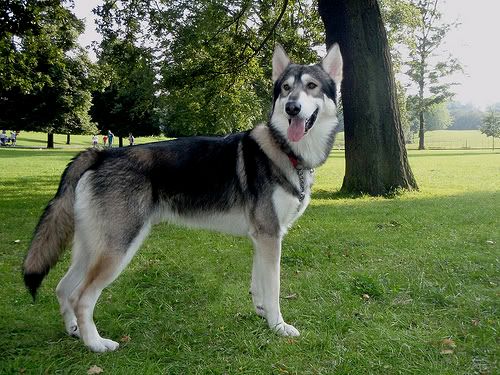 The Northern Inuit is the first attempt at creating a “wolflike” dog breed sans wolf content. They have a sorted history with so much squabbling that a whole host of “breeds” were established on their coat tails, but honestly none aside from the Tamaskan have gone anywhere away from constantly breeding mutts in a futile attempt to create a standard that never seems to breed true (it’s a long shot, here, but it might have something to do with the fact that new dogs outside of the “breed” are still being added). The NI got its start by mixing of huskies, malamutes, and GSDs to get a wolfy look, but ideally, to create a more trainable temperament. The breed has been handled so haphazardly, however, that there is no uniformity even after 20 years, there are still more dogs being crossed into the population, and the breed’s health is questionable because good records were never kept. To keep things even more confusing, the breed split into the Northern Inuit and British Inuit because of politics, but both “breeds” are equally in the crapper. Of course, if you visit the Northern Inuit Society Website you’ll get a whole lot of propaganda about breed standards, dog shows, and how the dogs were bred from “*~*actual Inuit dogs!!!*~*" but any amount of actual research into these dogs and the people who breed them will tell you otherwise, especially considering there isn’t a single kennel club that admits them as a breed. Long story short, I’m going against my own attempt at being unbiased and flat out telling you NOT to buy one of these dogs. They are pretty much a glorified designer dog and there are much better options for “wolfy” looking dogs (like adopting a rescue husky or malamute, for example!) Tamaskan Dogs 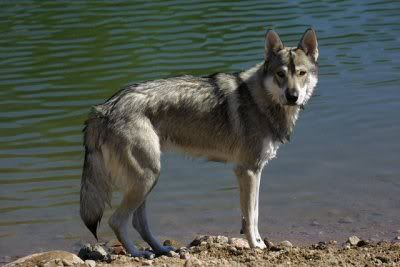 After various failures with NI dogs, the one branch that managed to successfully create the ideal “wolfy dog without wolf content” is the Tamaskan. The people involved with this off shoot understood that health, lineage, and breeding to standard without addition of outside breeds was necessary to create an actual breed. Although the Tamaskan isn’t currently accepted in any registry, there is a registry in place similar to the one created for CsVs where pedigrees are tracked help further the lines. Here’s a big, long explanation of how the breed developed from the Tamaskan Dog Register that also goes into NI dogs and the failures with that breed and other off-shoots: Tamaskan Dog Register posted:The first dogs to start the ball rolling, leading to the Tamaskan Dogs of today, came over from America in the 80’s. These 5 dogs were imported into UK and described as husky type dogs – origins unknown. Tamaskans are strikingly similar to CsVs, but their temperament is MUCH more docile and easy to train, and to keep as a family pet (although one should not forget the dogs used to form the breed, and while they are “easy” by Primitive Breed/spitz standards, they will still retain some of the intelligence and stubbornness of their ancestors). These dogs are pretty much bred to be easier wolfy dogs, with temperaments more akin to American Show GSDs or labs and goldens than a high drive working dog. They appeal to people who love the look of huskies and other sledding dogs, but who wouldn’t be able to handle all that energy. Of course, Tamaskans aren’t without their own level of drama. There is ANOTHER off shoot of the breed, the “Tamaskan Wolfdog” is being bred by people going back and mixing in other breeds like CsVs and Saarloos that actually have wolf content, and actual, high content wolfdogs in some cases. These dogs are NOT endorsed at all by true lovers of the breed since the whole goal is a wolfy breed with zero wolf, and every effort is being made to push bad breeders away from the dogs that are actually breeding true: The National Tamaskan Club of America[/url posted:There are those claiming to have Tamaskan dogs and misleading the public by selling cross-breeds or dogs unrecognized/unregistered by the TDR. These breeders are calling their dogs Tamaskan Wolfdogs. You will find advertisements throughout the Internet listing their dogs as Wolf Hybrids, Tamaskan Wolfdogs and High Content Wolf Hybrids. Do not be misled by these advertizments. Web sites such as, Nextdaypets, Pet4You, AAApets and AnyPetlist their puppies for sale. Use caution when searching for a Tamaskan Dog and check the Tamaskan Dog Register (TDR) https://www.tamaskan-dog.com for a list of Registered breeders.
|
|
|
|
rivals posted:Many of them are also good Schutzhund candidates though as I understand there is a slight rift in the community as to whether or not people should continue working their CsV's in SchH. As I understand it, when it comes to this breed you need the exact right temperament for it because if they are a little too "wolfy" in temperament (shy, standoffish, nervous or possibly too independent) and you work on bitework with them, you could have a very bad outcome. WolfBag please correct me or add to this if I'm off base anywhere You're right about the rift, but a little off on the reason. It's not really because they're shy since it actively says in the standard that shyness is a fault (although obviously a shy dog should NOT be trained in bite work). It's more to do with the independent temperament. CsVs, along with other primitive breeds, can get bored with sports because they learn fast and dislike competition. It's said CsVs are great for actual work and know to apply themselves in real situations, but do poorly when it's just a game to earn points. The problem comes in when the dogs start thinking for themselves. You teach a dog to bite, what happens when they decide the best instance to bite, without direction from you? While some dogs have a more biddable personality and do well with the sport, a lot of dogs do not. This is where the rift comes in. Most people are fine with not doing bite work, but others feel it should be a goal in breeding. Personally, I feel this would change their temperament just into a GSD clone, but that's just me. 
|
|
|
|
Eggsucker posted:The Vlacks have amazing snarling faces when they growl. This owner trained his dog to look mean on command, but it's completely non-aggressive. If I saw this pup snarling at me, I would be pretty worried. That doesn't look at all like a CsV to me...  Hard to tell with just the head, though. Hard to tell with just the head, though.It's funny, though, I was JUST wondering this morning how they teach dogs to growl on command for things like movies. Obviously there has to be a safe way to do it.
|
|
|
|
hahaha Buddy does that, too! Pretty much every time he goes in the yard, he does a perimeter sweep, does his business, then just sits on the patio looking around. You know, I was thinking about different Primitive dogs and how dogs like Shibas, Akitas, Basenjis, etc. are different from sledding/spitzy dogs, and I think I figured out how you can pin it down. Obviously each breed is going to be different based on what exactly they were bred for, but I think where sledding/spitz breeds tend to keep a lot of wolfy behaviors in the way they interact with eachother and with humans, more Japanese/feral type dogs are more like Village Dogs, or the predecessors of the domestic dog. They seem to have more of the "gently caress you" attitude than other breeds in that they are SO instinctively out for themselves, because wild dogs would have to be to survive. Just a thought, I figured I'd see what the rest of you (especially Pfox) think, since I have less experience with those types of breeds.  Also, Buddy's getting a bath today.
|
|
|
|

|
| # ¿ Apr 27, 2024 16:21 |
|
Pretty Cool Name posted:Your images appear to be broken. They work fine for me.  Yeah, your pup is most definitely a mix, looks like possibly husky or chow, maybe. Either would put you in this thread.
|
|
|


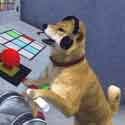


 . Where does the Iditarod fall?
. Where does the Iditarod fall?
